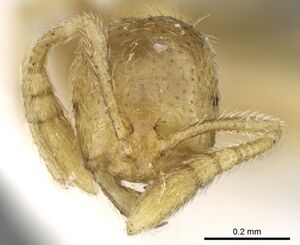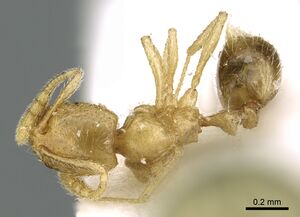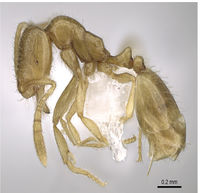Syllophopsis saudiensis
| Syllophopsis saudiensis | |
|---|---|

| |
| Scientific classification | |
| Kingdom: | Animalia |
| Phylum: | Arthropoda |
| Class: | Insecta |
| Order: | Hymenoptera |
| Family: | Formicidae |
| Subfamily: | Myrmicinae |
| Tribe: | Solenopsidini |
| Genus: | Syllophopsis |
| Species: | S. saudiensis |
| Binomial name | |
| Syllophopsis saudiensis Aldawood, 2016 | |
The new species was foraging in the upper layer of loose soil under a date palm tree Phoenix dectylifera L. with an understory of grasses. Only two workers were collected and this species was coexisting with many workers of Monomorium exiguum Forel, 1894 and Tapinoma simrothi Krausse, 1911. The soil was dry but rich in organic material. Specimens were collected using a sifting tray. The paratype specimen from Al Qatif was found in the soil around a date palm tree and associated with the ants Nylanderia jaegerskioeldi (Mayr, 1904), Monomorium monomorium Bolton, 1987, Monomorium carbonarium (Smith, 1858), and Tapinoma melanocephalum (Fabricius, 1793). It is noteworthy to mention the habitats preference of this group of tiny yellow ants is confined to soil, and leaf litter surrounding P. dectylifera trees. The type localities of both Syllophopsis kondratieffi and S. saudiensis have extensive date palm plantations.
Identification
Aldawood (2016) - Syllophopsis saudiensis seems closest to Syllophopsis thrascolepta from the Ivory Coast in body colour, eyes, antennae, outline of promesonotal dorsum, and body pilosity. Both species shares the following characters, colour yellow, eyes with one ommatidium; funicular segments 2–8 distinctly broader than long; scapes just reaching posterior margin of head when laid back from their insertions; dorsal outline of promesonotum evenly convex. However, S. saudiensis can be easily distinguished from S. thrascolepta by the following characters, cephalic pilosity is less abundant and sparse on median surface and lateral margins of head, eyes are smaller (EL 0.02 x HW), propodeum immediately after metanotal groove not raised, metanotal groove shallowly impressed, propodeal dorsum forming an obtuse angle with declivity, body pilosity less abundant, whereas in S. thrascolepta all cephalic surfaces are covered with long and dense hairs which appear as a fringe surrounding the posterior and lateral margins of head, eyes are distinctly larger (EL 0.07 x HW), metanotal groove in the form of U-shaped depression, propodeal dorsum meet declivity in a tiny but distinct dent, body pilosity profuse.
Syllophopsis saudiensis differs from the sole Arabian species, Syllophopsis kondratieffi by the longer scape (SL 0.41–0.42), and petiole (PL 0.17–0.18), the larger head width (HW 0.38–0.40), and postpetiole width (PPW 0.13), and the smaller pronotal width (PRW 0.11), versus SL 0.28–0.35, PL 0.12, HW 0.32–0.35, PPW 0.08–0.09, PRW 0.21–0.22 in kondratieffi. In addition, scapes of saudiensis when laid back from their insertions in full-face view reaching posterior margin of head, whereas in kondratieffi, scapes when laid back from their insertions fail to reach posterior margin of head. Moreover, the body pilosity in saudiensis is abundant and more stiff while it is sparse and fine in kondratieffi.
- Small species, TL 1.46–1.49, ML 0.44; scapes shorter (SI 88–100), when laid back from their insertions distinctly fail to reach posterior margin of head; body pilosity sparse and fine; colour uniformly clear pale yellow . . . . . Syllophopsis kondratieffi
- Larger species, TL 2.09–2.1, ML 0.53; scapes longer (SI 107), when laid back from their insertions distinctly reach posterior margin of head; body pilosity abundant and stiff; colour dirty yellow with brownish tint . . . . . Syllophopsis saudiensis
Distribution
The distribution of S. saudiensis may be similar to that of Syllophopsis kondratieffi in the central and eastern regions of Saudi Arabia, especially if the apparent preferred habitat occurs. Both species may have a wider distribution that could include other countries of the Arabian Peninsula.
Latitudinal Distribution Pattern
Latitudinal Range: 26.51028° to 25.88032°.
| North Temperate |
North Subtropical |
Tropical | South Subtropical |
South Temperate |
- Source: AntMaps
Distribution based on Regional Taxon Lists
Afrotropical Region: Saudi Arabia (type locality).
Distribution based on AntMaps
Distribution based on AntWeb specimens
Check data from AntWeb
Countries Occupied
| Number of countries occupied by this species based on AntWiki Regional Taxon Lists. In general, fewer countries occupied indicates a narrower range, while more countries indicates a more widespread species. |

|
Estimated Abundance
| Relative abundance based on number of AntMaps records per species (this species within the purple bar). Fewer records (to the left) indicates a less abundant/encountered species while more records (to the right) indicates more abundant/encountered species. |

|
Biology
Habitat. The new species was foraging in the upper layer of loose soil under a date palm tree Phoenix dectylifera L. with an understory of grasses. Only two workers were collected and this species was coexisting with many workers of M. exiguum Forel, 1894 and Tapinoma simrothi Krausse, 1911. The soil was dry but rich in organic material. Specimens were collected using a sifting tray. The paratype specimen from Al Qatif was found in the soil around a date palm tree and associated with the ants Nylanderia jaegerskioeldi (Mayr, 1904), M. monomorium Bolton, 1987, M. carbonarium (Smith, 1858), and T. melanocephalum (Fabricius, 1793). It is noteworthy to mention the habitats preference of this group of tiny yellow ants is confined to soil, and leaf litter surrounding P. dectylifera trees. The type localities of both kondratieffi and saudiensis have extensive date palm plantations.
Castes
Known only from the worker caste.
Worker
Images from AntWeb
   
| |
| Paratype of Syllophopsis saudiensis. Worker. Specimen code casent0919825. Photographer Michele Esposito, uploaded by California Academy of Sciences. | Owned by CAS, San Francisco, CA, USA. |
   
| |
| Paratype of Syllophopsis saudiensis. Worker. Specimen code casent0906341. Photographer Estella Ortega, uploaded by California Academy of Sciences. | Owned by NML, Liverpool, UK. |
Nomenclature
The following information is derived from Barry Bolton's Online Catalogue of the Ants of the World.
- saudiensis. Syllophopsis saudiensis Aldawood, 2016: 140, figs. 2, 3 (w.) SAUDI ARABIA.
- Type-material: holotype worker, 2 paratype worker.
- Type-locality: holotype Saudi Arabia: Riyadh Prov., Al Majma’ah, 25.88036°N, 45.36566°E, 743 m., 14.ii.2015 (S. Salman); paratypes: 1 worker with same data but 25.88032°N, 45.36531°E, 730 m., 7.i.2015, 1 worker Saudi Arabia: Eastern Prov., Al Qatif, 26.51028°N, 49.96889°E, 30 m., 14.iv.1984 (C.A. Collingwood).
- Type-depositories: KSMA (holotype); CASC, WMLC (paratypes).
- Distribution: Saudi Arabia.
Unless otherwise noted the text for the remainder of this section is reported from the publication that includes the original description.
Description
Worker
Holotype (paratype in brackets). EL 0.01 (0.01); HL 0.48 (0.48); HW 0.38 (0.40); ML 0.52 (0.54); PL 0.18 (0.17); PPL 0.10 (0.10); PPW 0.13 (0.13); PW 0.11 (0.11); SL 0.41 (0.42); TL 2.11 (2.09). Indices: CI 79 (82); SI 107 (107).
Head. Rectangular with slightly convex sides; posterior margin of head feebly concave in full face view; posterior corners of head broadly rounded; masticatory margin of mandibles with four testaceus teeth, fourth tooth same size as third; anterior clypeal margin feebly concave; median clypeal portion distinctly raised and bicarinate; apical funicular segment longer than the two proceeding segments together; funicular segments 2–8 broader than long; antennal scapes when laid back from their insertions reaching the posterior margin of head; eyes minute, of a single ommatidium, situated at the mid-length of head sides. Mesosoma. Metanotal groove shallowly but distinctly impressed; propodeal dorsum flat, lower than promesonotal dorsum, nearly twice longer than declivity in profile, slightly sloping posteriorly, making obtuse angle with declivity; propodeal spiracle tiny and circular. Petiole. Petiole with long anterior peduncle and high node in profile; dorsal surface of petiole gently sloping anteriorly and posterior surface sloping abruptly. Postpetiole. Postpetiole lower than petiole in profile, globular and broader than long in dorsal view. Gaster. Sting well-developed. Sculpture. Body smooth and shining, except impression between mesopleuron and metapleuron faintly cross-ribbed. Pilosity. whole body covered with abundant hairs, cephalic pilosity shorter and stiff; propodeal dorsum bare; dorsum of pronotum and mesonotum with several pairs of long, erect hairs; pilosity of mesosoma, petiole, postpetiole and gaster fine and longer than cephalic pilosity; antennae covered with dense decumbent pubescence; petiole with several short decumbent hairs and one pair of long hairs. Colour. Yellow with brownish tint on head and gaster.
Type Material
- Holotype, worker, Riyadh Province, Al Majma’ah, 743m, Saudi Arabia, 25°52′49″N 45°21′56″E / 25.88036°N 45.36566°E, 14 February 2015, S. Salman, King Saud Museum of Arthropods.
- Paratype, 1 worker, Riyadh Province, Al Majma’ah, 730m, Saudi Arabia, 25°52′49″N 45°21′55″E / 25.88032°N 45.36531°E, 7 January 2015, S. Salman, casent0919825, California Academy of Sciences.
- Paratype, 1 worker, Al Qatif, Eastern Province, 30m, Saudi Arabia, 26°30′37″N 49°58′08″E / 26.51028°N 49.96889°E, 14 April 1984, C. A. Collingwood, casent0906341, World Museum, Liverpool.
Etymology
The new species was named after the country of the type locality.
References
- [[Media:Aldawood, A.S. 2016. Ants of the genus Syllophopsis in Saudi Arabia.pdf|Aldawood, A.S. 2016. Ants of the genus Syllophopsis Santschi, 1915 (Hymenoptera: Formicidae) in Saudi Arabia with description of a new species. Zoology in the Middle East. 62(2):137-143. DOI: 10.1080/09397140.2016.1*Sharaf, M.R., Abdel-Dayem, M.S., Mohamed, A.A., Fisher, B.L., Aldawood, A.S. 2020. A preliminary synopsis of the ant fauna (Hymenoptera: Formicidae) of Qatar with remarks on the zoogeography. Annales Zoologici 70: 533-560 (doi:10.3161/00034541anz2020.70.4.005).
173898.]]

